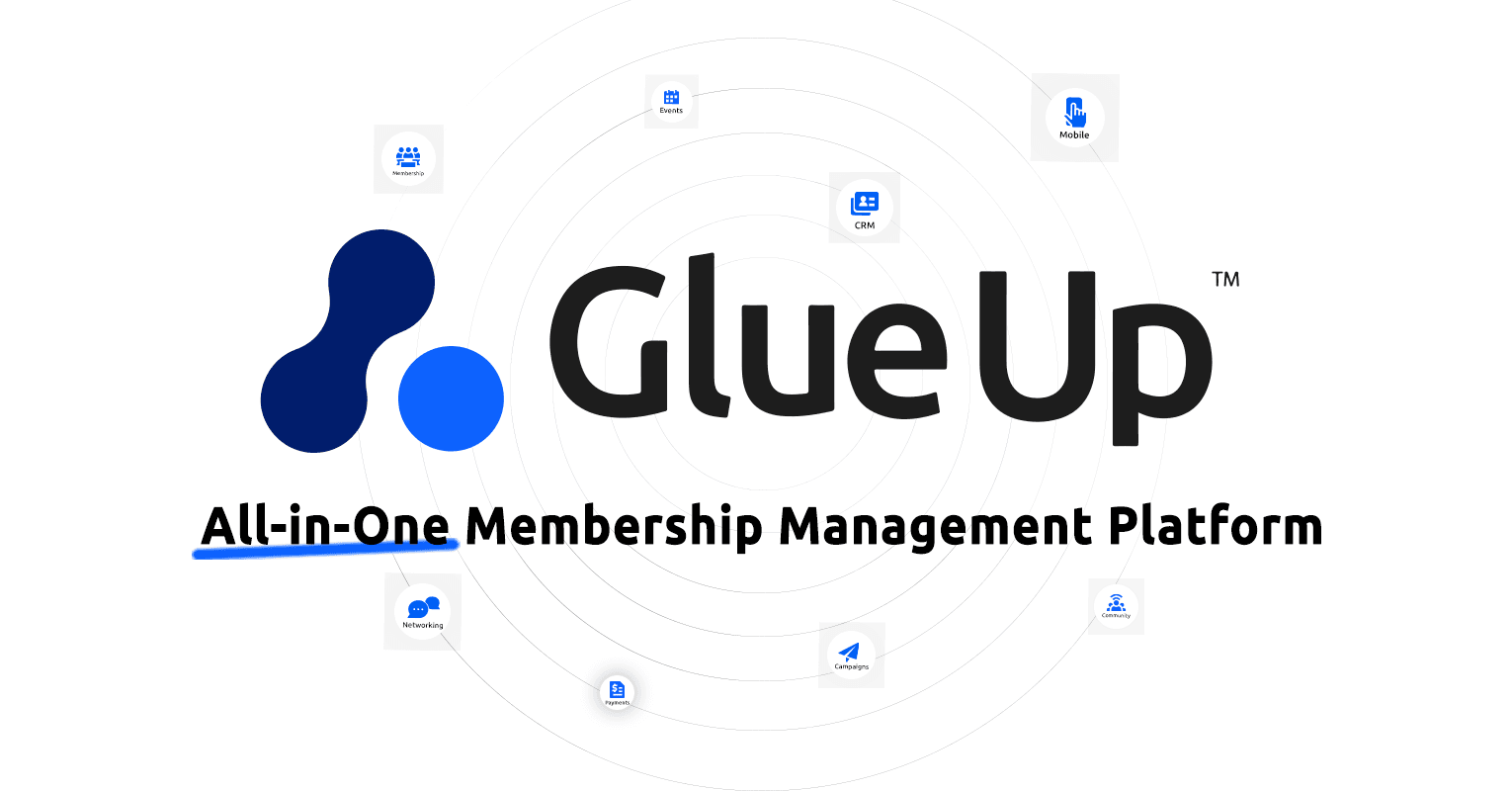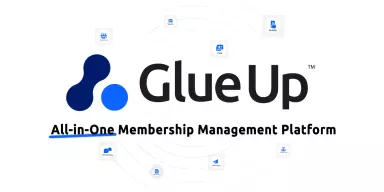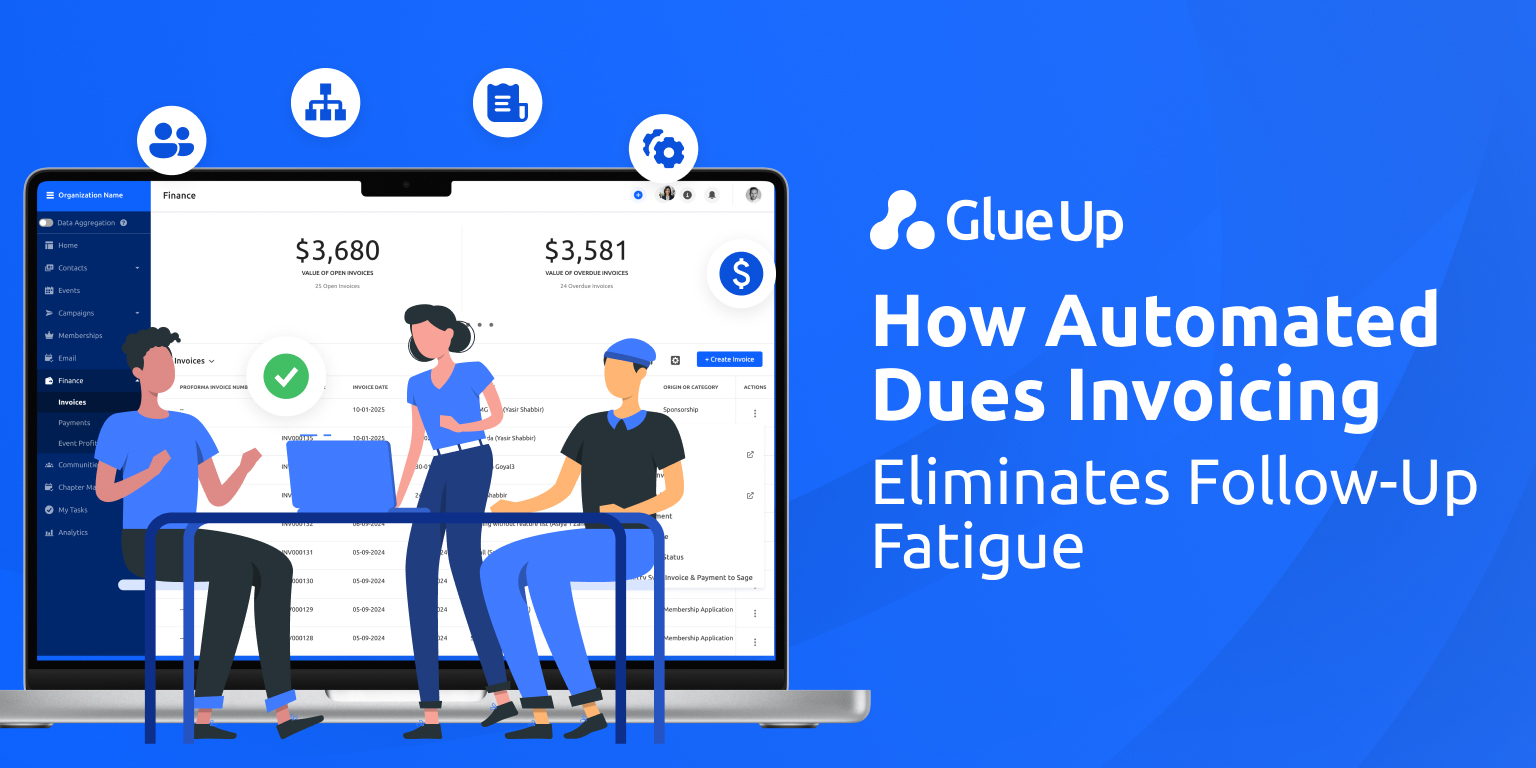
You’ve heard it everywhere: “We need AI for engagement.” The idea sounds irresistible: personalized experiences, predictive renewals, and smarter communication. But when you actually try to operationalize AI-driven engagement, the optimism fades into spreadsheets, scattered records, and compliance questions no one can answer.
The truth is, no model, not even the most advanced neural net, can thrive on messy, inconsistent member data. AI is a math powered by quality information. And in associations, chambers, and member-based organizations, that data is often fragmented across systems, locked in emails, or mislabeled in event lists.
This is where the work begins.
In this playbook, you’ll learn how to prepare your data for ai-driven engagement: what to collect, how to clean it, how to govern it, and how to connect it to outcomes your board actually cares about. Along the way, we’ll show how Glue Up’s ecosystem, its membership CRM, event tools, community module, Finance Suite, and AI Copilot, makes it possible and practical.
Key Takeaways
AI success starts with clean, unified data. Most AI engagement projects fail because of poor data hygiene. Consolidating, cleaning, and governing your data is the real foundation of effective AI-driven engagement.
Focus on measurable, high-impact use cases first. Start with practical applications where data is rich and results are tangible.
Map only the data you truly need. Collect essential member information and connect them in one structured system like Glue Up’s platform.
Run the AI-readiness checks. Identity resolution, deduplication, timestamp normalization, missing data handling, and schema validation prevent inaccuracies that can derail predictions.
Label outcomes with precision. Define what “success” looks like and ensure consistent labeling for accurate AI learning and prediction.
Compliance builds trust Address GDPR, CCPA, and AI ethics requirements early. Transparency, data protection, and fairness are prerequisites for long-term member confidence.
Build a continuous data preparation pipeline. From ingestion to activation: unify, clean, validate, label, govern, and deploy data so that engagement becomes proactive.
Pilot before scaling. Use a 30-60-90-day framework to test AI initiatives. Measure outcomes like renewal intent or engagement lift before full rollout.
Quantify ROI in executive language. Translate engagement results into financial metrics: renewal lift, event revenue growth, reduced support costs, and improved efficiency.
Make ethics a habit. Regular bias audits, model transparency, and retraining cycles ensure fairness and sustain member trust.
Keep leadership and teams aligned. Communicate outcomes through dashboards, celebrate small wins, and maintain transparency across all AI initiatives.
Glue Up is the foundation for scalable AI-driven engagement. Its all-in-one ecosystem removes silos and gives associations a ready-made infrastructure for intelligent engagement.
Data maturity defines the future of engagement. The most successful associations will treat AI as a culture: data-literate, transparent, and human-centered.
Quick Reads
The Real Reason Most AI Engagement Projects Stall
Every few months, a new report announces the rise of “AI-first engagement.” Yet internal postmortems tell a quieter story: promising pilots that fizzle. The pattern is strikingly consistent. The models work fine, but the data doesn’t.
A recent McKinsey analysis found that poor data quality adds friction to 70 percent of AI initiatives, and Gartner estimates it costs organizations an average of $15 million annually. In member organizations, that friction shows up as duplicate profiles, incomplete attendance logs, and disconnected payment histories.
So, before you chase the next AI trend, fix the foundation. AI-driven engagement is less about algorithms and more about architecture, one that connects how your organization collects, governs, and activates information. Glue Up’s unified system gives you that structure out of the box, but the mindset must come first: treat data preparation as a strategic discipline, not a technical chore.
Step 1: Pick Use Cases That Actually Move the Needle
AI can technically personalize everything, from event invitations to committee placements, but that doesn’t mean it should. Associations often get trapped in “AI everywhere” thinking, trying to automate too many touchpoints too soon. The smarter move is to begin where your data is strongest, your teams already act with consistency, and your outcomes are measurable in weeks.
Think of AI-driven engagement as a living system: every use case you select should teach you something about how members behave, how your data flows, and how your organization responds. Start small but start where the stakes are meaningful.
1. New-Member Onboarding Journeys
Every membership lifecycle begins with momentum, and risk. Studies in behavioral economics show that early satisfaction shapes long-term loyalty; in associations, more than 60 percent of member churn occurs within the first 45 days. That window is your opportunity to design experiences that reinforce belonging.
An AI-assisted onboarding journey can track behavioral signals like event registrations, email opens, or community logins to trigger timely nudges. For example, if a new member attends an introductory webinar but hasn’t joined a community group, the system can recommend one with similar interests. If they open emails about mentorship programs but never click through, AI can adjust the next message’s timing or tone.
With Glue Up’s CRM and event management modules, these signals already exist in one ecosystem. You’re activating the data you already have. The result is an onboarding process that feels personal without feeling intrusive, data-driven but deeply human.
2. Churn-Risk Scoring
Retention is understanding why someone drifts away. Traditional engagement tracking: open rates, attendance counts, dues reminders; tells you what happened. AI changes that equation.
By analyzing multiple behavioral and transactional data points, such as event attendance frequency, delayed payments, or prolonged community silence, AI can flag early signs of disengagement. That insight lets your team act preemptively rather than reactively.
Glue Up’s Finance Suite, CRM, and Community data create a natural foundation for these models. When a member’s renewal likelihood drops below a threshold (say 70 percent), an automated workflow can trigger a personalized outreach or incentive offer, such as a renewal discount or targeted communication from a chapter chair.
The deeper value here is empathy. AI-driven engagement at this stage allows associations to show attentiveness before a member consciously considers leaving, a digital form of emotional intelligence at scale.
3. Event Fill Optimization
Events are the heartbeat of most associations, yet underfilled sessions are a persistent frustration. Predictive analytics can change that. Using historical attendance data, engagement signals, and registration timing patterns, AI can forecast which events are likely to underperform weeks in advance.
With that insight, your marketing team can redirect campaigns, adjust pricing tiers, or send targeted reminders to members who previously engaged with similar content. Glue Up’s Smart Lists and event analytics make these micro-adjustments automatic, ensuring no event quietly fails due to lack of visibility.
This is where AI-driven engagement moves from personalization to prediction, turning intuition into actionable foresight. You’re observing and responding in real time.
4. Content Recommendations
Attention is the new currency, and members spend it selectively. AI-powered recommendation engines, long used in consumer spaces like Netflix or Spotify, now hold real promise for associations.
By analyzing how members interact with newsletters, community discussions, and event topics, AI can suggest relevant resources, from webinars to policy updates. When a member reads an article on advocacy, the system might recommend a related white paper or upcoming legislative briefing. Over time, these micro-recommendations compound into a personalized learning path that reinforces the value of membership.
Glue Up’s Community and Email tools already collect the necessary behavioral metadata. Layering AI on top turns this passive data into active guidance, ensuring every member feels that the next opportunity, event, or article was meant for them.
Retention is consistent intellectual engagement. Members stay where they feel seen and intellectually stimulated, and AI-driven engagement ensures they are.
5. Support Triage and Summarization
Service quality defines reputation. Yet member support often drowns in emails, tickets, and disjointed threads. AI can bring clarity and speed to this chaos.
Modern natural language models can categorize support requests by urgency, detect sentiment, and even summarize long email chains into concise briefs for faster handoffs. Instead of staff combing through lengthy back-and-forths, AI organizes and prioritizes the workload, so human agents focus on resolving issues.
This is where Glue Up’s AI Copilot excels. It can instantly summarize communications, highlight key action points, and draft professional replies aligned with your organization’s tone. The payoff is twofold: members receive timely, thoughtful responses, and staff regain hours of productive time.
Good support is a real-time engagement touchpoint. Every resolved issue becomes a reinforcement of trust, and trust fuels every other metric of engagement.
Each of these use cases reveals one common truth: AI-driven engagement succeeds when it’s grounded in clean, contextual, and connected data.
Technology amplifies patterns, but data defines direction. When your systems speak the same language and your teams align on measurable goals, AI becomes less of an experiment and more of an operating system for meaningful human connection.
Step 2: Map the Data You Actually Need
Many teams drown trying to capture everything. The secret is sufficiency, collect just enough to make intelligent decisions.
| Category | Data Points | Where It Lives in Glue Up |
|---|---|---|
| Membership CRM | Join date, renewal date, tier, committees, activity score | Membership Module |
| Events | Registrations, attendance, no-shows, session type | Event Management |
| Engagement Signals | Community posts, email opens/clicks, downloads | Community + Email |
| Finance | Payments, refunds, outstanding invoices | Finance Suite |
| Attributes | Role, company size, industry, location | CRM Profiles |
Together, these sources create what data scientists call a “feature store”, a structured environment where each variable describes how members behave and respond. Glue Up already connects these elements, turning what used to be manual exports into a living engagement ecosystem.
Step 3: Run the Nine Checks for AI-Ready Data
Before models, dashboards, or pilot programs, run these checks. If you skip them, AI will exaggerate your data’s worst habits.
Identity resolution: one profile per person.
Deduplication: eliminate repeated records across imports.
Timestamp normalization: use a single format (UTC) across modules.
Missing-data strategy: decide whether to impute, ignore, or flag gaps.
Category standardization: unify industry, location, and membership tiers.
Outlier management: cap extreme values that distort patterns.
Schema validation: every transaction must tie to a real member ID.
Feature documentation: maintain a data dictionary explaining each field.
Label reproducibility: store how outcomes, like “renewed” or “inactive”, are defined.
Associations often discover that step 1 alone (identity resolution) removes 20–30 percent of false duplicates. Once that’s cleaned, AI predictions instantly stabilize.
Step 4: Label What Success Looks Like
AI learns from examples. That means you must clearly label the outcomes you care about.
Define the result. Renewal, registration, upgrade, referral, pick one.
Mark the timeframe. “Renewed within 30 days,” not “renewed eventually.”
Use behavioral primitives. Clicks, posts, RSVPs, and payments are your verbs.
Automate consistency. Glue Up logs every interaction; use these as labeled events.
Audit and version. Store label definitions so results can be reproduced later.
Imagine you’re predicting event attendance. If you mislabel “invited” as “attended,” your model will treat disinterest as engagement. Labeling is the hinge between curiosity and accuracy in AI-driven engagement.
Step 5: Address Privacy and Compliance Before You Build
AI engagement relies on trust, and trust depends on compliance. European regulations like GDPR and the EU AI Act, and U.S. state laws like California’s CCPA, require clarity about automated decision-making. Associations that manage global memberships must get this right.
Create a simple pre-flight checklist:
Lawful basis for profiling: document why you process data (consent, contract, legitimate interest).
Data Protection Impact Assessment (DPIA): run one if your use case carries risk.
Human review: offer appeal paths for decisions that affect benefits or access.
Retention limits: don’t store PII longer than necessary.
Bias testing: evaluate performance across demographics.
Transparency: disclose AI use in privacy notices.
Model governance: record version, training data, and metrics.
Security: encrypt data at rest and in transit.
Member preferences: synchronize opt-outs across communication channels.
Glue Up simplifies much of this with audit logs, role-based access, and preference centers, helping associations remain compliant while pursuing personalization.
Step 6: Build Your Data Preparation Pipeline
Think of this as the factory line behind your AI program, the quiet, disciplined process that transforms scattered information into meaningful insight. Once it’s running, it learns from them, improving quality and precision over time.
In every successful AI initiative, data preparation is 80 percent of the work. It’s the unglamorous part, but it’s also where competitive advantage lives. Associations that invest in clean, unified, and well-governed data make it sustainable. Glue Up’s ecosystem gives you this backbone natively, but the discipline comes from how you maintain it.
Here’s how to build that pipeline step by step.
A. Ingest and Unify
The first task is visibility. Associations typically store data in multiple silos: membership CRMs, event registration tools, payment gateways, email marketing systems, and community forums. Each contains pieces of the engagement puzzle, but none tell the whole story on their own.
An AI-driven engagement strategy begins by bringing all those sources together into a structured environment. Glue Up simplifies this process because its ecosystem already integrates membership, event, community, finance, and communication data within one cloud. You don’t need a dozen connectors or APIs; the data already flows in real time.
Once unified, your data becomes a living reflection of your members: how they register, attend, renew, post, pay, and interact. The key is to keep this ingestion continuous. Data unification is an always-on process that mirrors the rhythm of your organization.
B. Resolve Identities
Once your data is centralized, the next challenge is ensuring that every record truly represents one person. Duplicates and mismatched identities are the most common reason AI models' misfire.
Start with deterministic matching, exact identifiers like email, member ID, or phone number. Then move to probabilistic methods that look at name similarity, company affiliation, or geographic proximity. If “Jessica L.” and “J. Lewis” from the same firm appear in separate datasets, probabilistic logic helps merge them safely.
Glue Up’s CRM structure inherently reduces duplication, but running periodic audits keeps your dataset healthy. Over time, identity resolution builds trust in your predictions. When you know who’s who, you can finally understand why they engage.
C. Clean
Cleaning is the most essential act of care you can show your data. It’s where quality is won or lost.
At this stage, you’ll correct formatting inconsistencies (dates, currencies, capitalization), address missing values, and standardize language across fields (for instance, “Gold Tier,” “Gold,” and “Tier 1” should all mean the same thing).
Document each transformation: what changed, why, and when. These records become your “data journal,” useful for audits, retraining models, and proving compliance. Think of it as digital hygiene; your AI is only as healthy as the data it consumes.
D. Validate
Once the cleaning is done, validation ensures your structure holds up under pressure.
Run automated checks for null values, foreign-key mismatches, and range errors. A simple script that alerts your team when member IDs don’t match payment records can prevent weeks of downstream debugging.
Glue Up’s reporting and export tools help with this step because you can validate directly within its unified environment, eliminating the guesswork that comes from juggling multiple systems.
When validation becomes routine, your analytics evolve from “we think this is accurate” to “we know this is accurate.” That confidence is what executives and boards need to trust AI-driven engagement decisions.
E. Engineer Features
Here’s where data becomes intelligence. “Feature engineering” might sound technical, but it simply means creating metrics that describe meaningful behavior.
Think about how you measure member relationships today: attendance, email opens, payments, referrals. Now imagine giving those actions mathematical structure:
Recency: How recently did the member engage?
Frequency: How often do they attend or respond?
Monetary: How much value do they bring (dues, purchases, donations)?
Velocity: How quickly do their engagement patterns change?
Diversity: How many different channels or activities do they interact with?
These derived features become the vocabulary your AI model speaks. In Glue Up, they’re easy to calculate because every interaction, whether from Events, Community, or Finance, ties back to a single member record.
Done right, feature engineering turns ordinary data into behavioral storytelling. It allows your AI to recognize what they’re likely to do next.
F. Label
Every predictive model needs a teacher, and that teacher is labeled data. Labeling defines the “truths” your AI should learn from.
For example:
Members who renewed = 1
Members who lapsed = 0
Members who registered for an event = 1
Members who viewed an event page but didn’t register = 0
Start with outcomes that are easy to track, like renewals or event attendance. Over time, you can add more nuanced labels such as “active contributor,” “potential sponsor,” or “mentor candidate.”
Glue Up’s engagement data provides these outcomes naturally; your job is to define them consistently. Labeling transforms data from passive observation into actionable learning.
G. Split Datasets
AI models must learn without cheating. That’s why data scientists divide information into three groups: training, validation, and testing.
Training data teaches the model patterns.
Validation data tunes its performance.
Test data checks how it performs on new, unseen cases.
For associations, this ensures your predictions, like churn risk or event interest, work on future members. It’s a safeguard against false confidence.
Even if you’re not building models yourself, this concept matters. Glue Up’s upcoming AI integrations follow the same logic behind the scenes, ensuring fairness and reliability in every prediction you see.
H. Govern
Governance is where credibility lives. It’s accountability.
Establish ownership for each dataset. Who’s responsible for updates, audits, and privacy compliance? Maintain a lineage log that tracks where each data element came from, what transformations were applied, and which systems now consume it.
Regulatory frameworks like the EU AI Act and GDPR are increasingly explicit about governance expectations. Glue Up already gives you audit trails, consent tracking, and role-based access controls. Use them proactively.
When governance is built in from the start, AI stops being a compliance risk and becomes a trusted partner in decision-making.
I. Activate
Now comes the reward, activation.
Clean, labeled, and governed data becomes fuel for real-world engagement. Feed it into your Glue Up Smart Lists to target the right members, trigger automated renewal campaigns, or power AI Copilot suggestions that draft personalized messages in seconds.
For instance, your churn-risk model might feed a Smart List of “members likely to lapse in 30 days.” AI Copilot then writes customized outreach emails while your team monitors responses in real time.
This is AI-driven engagement at its most tangible: data flowing effortlessly into actions that feel human. Insights translating directly into outcomes.
Why This Pipeline Matters
By automating your data preparation pipeline, your association shifts from reactive reporting to proactive decision-making. Instead of waiting for problems: low renewals, empty events, disengaged members; you predict and prevent them.
This pipeline makes your organization learn. Every iteration teaches the system something new about your members. And because Glue Up integrates each step, building institutional intelligence on a single, trustworthy foundation.
In the end, data preparation is a habit. And once that habit takes root, AI-driven engagement stops being an aspiration and becomes the way your organization naturally operates: precise, personal, and always one step ahead.
Step 7: Launch a 30-60-90 Day Pilot
Big transformations start small. A 90-day pilot keeps momentum while giving you measurable results.
Days 1–30 – Baseline
Connect Glue Up modules and run your nine data checks.
Choose one measurable goal, such as “increase renewal intent by 3 percent.”
Label and clean historical data.
Days 31–60 – Model & Activate
Build a simple logistic-regression or tree-based model.
Identify thresholds (for example, members with ≥ 70 percent churn risk).
Segment those members into Smart Lists.
Use AI Copilot to craft personalized outreach messages.
Days 61–90 – Evaluate & Scale
Compare renewal and engagement rates between the AI-driven cohort and control.
Report revenue lift, cost per save, and time saved by staff.
Present findings to leadership with a live dashboard.
If the pilot shows lift, and it will when data quality is solid, you’ve earned the mandate to expand. That’s how AI-driven engagement becomes culture.
Step 8: Measure ROI Like a Finance Director
Executives invest in outcomes. Translate engagement into numbers they understand.
Renewal rate lift: (New % – Old %) × Average Dues
Event revenue lift: Extra registrations × Average ticket price
Support cost reduction: Hours saved × Hourly rate
Automation efficiency: Campaigns launched per staff member
Engagement velocity: Time between first touch and action
Glue Up’s unified analytics makes these metrics visible without exporting spreadsheets. When leadership sees that AI-driven engagement equals revenue and retention, support for further automation follows naturally.
Step 9: Make Ethics a Habit
The hardest part of modern AI is the morality. Bias creeps in silently through imbalanced data or unconscious labeling. Privacy erodes when convenience shortcuts governance.
Create structures that prevent both:
Bias audits: Compare prediction accuracy across gender, geography, or membership tier.
Explainability: Keep simple, interpretable models where possible.
Opt-outs: Respect human autonomy. No one should feel trapped in automation.
Model cards: Document inputs, assumptions, and intended uses.
Retraining cadence: Refresh quarterly to reduce drift.
AI that respects people earns their trust. And trust is the real driver of engagement; AI merely amplifies it.
Step 10: Bring Your Board and Team Along
The best strategy in the world dies in silence if stakeholders don’t understand it. Communicate like a strategist, not a data scientist.
Frame AI as efficiency and foresight. It’s not replacing humans; it’s multiplying their time.
Start small. One pilot, one quarter, one metric.
Show dashboards, not decks. Let the numbers tell the story.
Celebrate micro-wins. Each percentage point of renewal lift matters.
Keep governance visible. Transparency builds confidence.
Why Glue Up Is the Right Foundation for AI-Driven Engagement
You could duct-tape tools together, a CRM here, a marketing platform there, or you could start with a system built for unification. Glue Up’s architecture is designed for the realities of member organizations:
All-in-one ecosystem: Membership, events, community, finance, and communications under one login.
AI Copilot: Drafts personalized content, summarizes insights, and assists with workflow decisions.
Smart Lists: Real-time segmentation that updates automatically as behavior changes.
Manager App: Gives teams mobility to manage approvals and renewals anywhere.
Data governance: Role-based access, consent tracking, and export logs aligned with compliance best practices.
In essence, Glue Up already does the heavy lifting of integration and governance so you can focus on designing human experiences powered by AI.
The Future of Engagement Is Data Maturity
AI won’t replace your membership team; it will elevate it. The organizations that win over the next decade will be those that treat AI-driven engagement as an operational discipline: data-literate, ethically sound, and relentlessly member-focused.
Here’s what to remember:
Engagement starts with data quality.
Privacy is a competitive advantage.
Clean data shortens the path from insight to action.
Measurement turns belief into proof.
Technology matters, but culture sustains it.
Closing Thoughts
If your association wants to move from reactive to predictive, from mass messaging to meaningful personalization, start with your data. AI-driven engagement is today’s competitive baseline.
Run the checks. Label the right behaviors. Govern your information. Pilot for 90 days. Measure what matters. And when you’re ready to see how a unified platform can make that transformation faster and safer, look at Glue Up, the AI-powered Association Management Cloud built for engagement, renewal, and growth.
Book a demo today and see how Glue Up can make AI-driven engagement a working reality for your organization.



